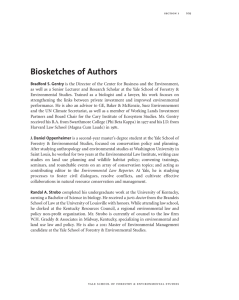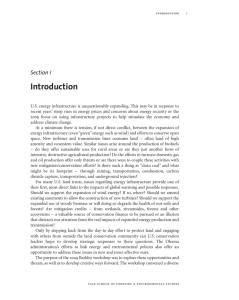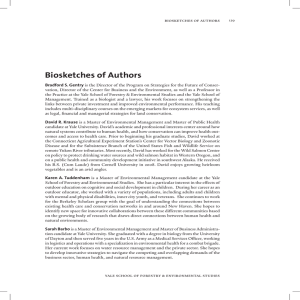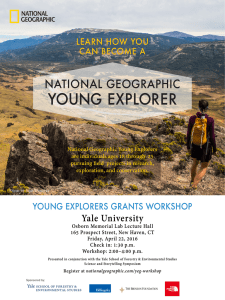Actions Underway — Healthcare Providers
advertisement
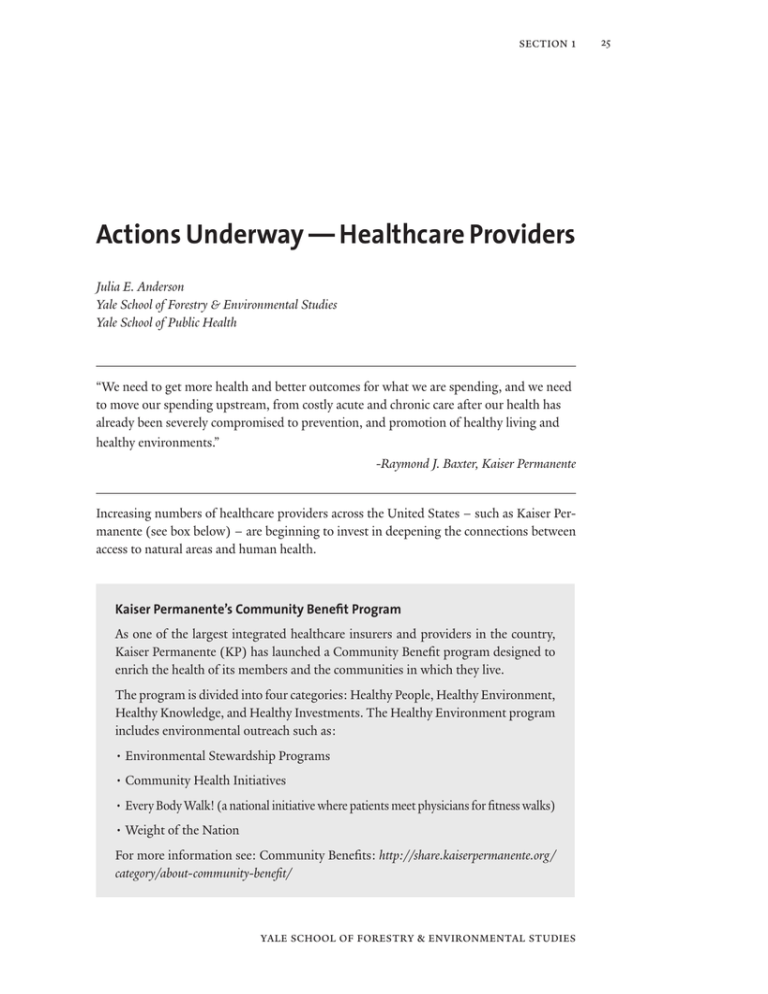
section 1 Actions Underway — Healthcare Providers Julia E. Anderson Yale School of Forestry & Environmental Studies Yale School of Public Health “We need to get more health and better outcomes for what we are spending, and we need to move our spending upstream, from costly acute and chronic care after our health has already been severely compromised to prevention, and promotion of healthy living and healthy environments.” -Raymond J. Baxter, Kaiser Permanente Increasing numbers of healthcare providers across the United States – such as Kaiser Permanente (see box below) – are beginning to invest in deepening the connections between access to natural areas and human health. Kaiser Permanente’s Community Benefit Program As one of the largest integrated healthcare insurers and providers in the country, Kaiser Permanente (KP) has launched a Community Benefit program designed to enrich the health of its members and the communities in which they live. The program is divided into four categories: Healthy People, Healthy Environment, Healthy Knowledge, and Healthy Investments. The Healthy Environment program includes environmental outreach such as: • Environmental Stewardship Programs • Community Health Initiatives • Every Body Walk! (a national initiative where patients meet physicians for fitness walks) • Weight of the Nation For more information see: Community Benefits: http://share.kaiserpermanente.org/ category/about-community-benefit/ yale school of forestry & environmental studies 25 26 improving human health by increasing access to natural areas: linking research to action at scale Some of these investments are in response to the need to reduce healthcare costs by preventing illnesses – as described in the quote above. Others are consistent with the provision in Section 9007 of the Affordable Care Act (ACA) that expands the community benefit requirements for non-profit hospitals and other providers. That provision encourages hospitals to address the root causes of disease in the communities they serve. These and other factors are creating an increasing number of opportunities for land conservation organizations to work with health providers to connect people with natural areas – within the hospitals themselves, across the neighborhoods the hospitals serve, and throughout the wider mix of natural areas that are protected for a broad array of public benefits, including health. This chapter outlines some of the collaborations already underway between health and conservation organizations – at the hospital, neighborhood, and regional scales. It is intended to start outlining a “menu” of ways that conservation organizations can consider reaching out to health care providers in their communities to explore possible collaborations. 1.1 The ‘Green’ Hospital Revolution “It took me 35 years of practicing medicine and a PhD in medical history to learn that sometimes it is better to treat a sick patient the way a gardener nurtures an ailing plant than the way a mechanic fixes a broken machine.” —Victoria Sweet, MD, PhD, Laguna Honda Hospital The Joint Commission for Accreditation of Hospitals, a non-profit organization that certifies more than 20,000 health care programs in the U.S., has recommended that: “patients and visitors should have opportunities to connect with nature through outside spaces, plants, indoor atriums, and views from windows” (Larson and Kreitzer, 2004). Perhaps this explains why landscape design in hospitals has become a flourishing business, as research unveils the positive effects that exposure to greenery has on mental and physical health. In addition to gardens, health care providers are working to create avenues to deliver nutritious foods to their facilities. Such efforts are designed to minimize hospital costs, improve patient satisfaction, reduce environmental footprints, and expand opportunities to integrate elements of the natural world into treatment and prevention. Healing Gardens In recent years, healing gardens have become increasingly popular in healthcare settings, as evidence from a growing body of research suggests that exposure to natural environments can improve both patient experience and health outcomes. It may come as no surprise that gardening is a therapeutic activity – it intimately connects people with nature, offers relief yale school of forestry & environmental studies section 1 from symptoms and stress, and improves well-being. Within the context of healthcare, the idea that fresh air, sunlight, and greenery provided by a garden can be good for an ailing body is knowledge that dates back to medieval times. Saint Hildegard von Bingen, a 12th century medieval nun, practiced a form of medicine deemed in Latin as viriditas – “greening power” – the ability of the human body, much like a plant, to grow, develop, and self-heal from injury or illness (Sweet, 2012). There is also evidence that incorporating nature into healthcare improves recovery outcomes. The most frequently cited study on this topic is a short paper published in Science in 1984. Titled “A View through a Window May Influence Recovery from Surgery,” Roger Ulrich’s study examined postoperative patients’ recovery in the presence and absence of a window with a view. Patients with windows that looked out onto trees had significantly shorter hospital stays, fewer negative comments, and needed less medication than patients with windows that looked out at a brick wall. These results suggest both that viewing nature has salutory effects on patients and implies cost saving advantages for hospitals that incorporate gardens into their design. Family members and hospital staff also benefit from being around nature. Hospitals can be particularly stressful environments for families to visit and wait for healing loved ones, as well as for staff to work. Burnout among health care providers, particularly nurses, is high (Mitrone, 2008). In a study that evaluated three healing gardens at the Children’s Hospital of San Diego Pediatric Cancer Center it was noted that the majority of garden visitors were not children, but adults and staff (Sherman et al., 2005). The Healing Gardens at Legacy Health, Portland, Oregon Legacy Health is a non-profit charitable institution made up of six hospitals that treat a wide variety of patients. Across this hospital system, eleven healing gardens have been created to offer tranquil retreats for patients, families, hospital staff, and the public. yale school of forestry & environmental studies 27 28 improving human health by increasing access to natural areas: linking research to action at scale The goal of the healing gardens is to give patients a much-needed place to rest that speaks to their psychological, physical, and spiritual needs, while also giving the hospital the opportunity to study and quantify the benefits that green spaces can have on patients, their families, and even health care professionals under stress. Legacy Health offers many examples of how nature can be integrated into treatment through their award-winning healing gardens, a Horticultural Therapy Certificate program and workshops on Children in the Garden. Images courtesy of Legacy Health Good Samaritan Hospital. For more information see: Nature Sacred: http://naturesacred.org/a-nature-placeportland-or-quantifying-benefits-of-a-healing-garden-among-hospital-populations/; Legacy Gardens: http://www.legacyhealth.org/health-services-and-information/health-services/ for-adults-a-z/horticultural-therapy/legacys-gardens.aspx A recently published article examined the relationship between exposure to green spaces and mental health outcomes – it found that “higher levels of exposure to green space were associated with significantly lower levels of symptoms for depression, anxiety, and stress” (Beyer et al., 2014). These results suggest that “greening” within a hospital setting, or encouraging experiences in the community that expose patients to greenery, could have positive health effects for patients suffering from mental illness, as well as visitors, family, staff, and the surrounding community. Community Garden in the Hill Neighborhood, New Haven, Connecticut This community garden offers a unique example of how hospitals with limited resources can develop healing gardens through collaboration with the local community and land trusts. This particular garden was established through a partnership between the adjacent neighborhoods and the nearby Connecticut Mental Health Center (CMHC). Technical assistance and supplies were provided by the New Haven Land Trust to support the creation of the garden. Since opening in August 2013, the garden has offered a place for mental-health patients of CMHC to work and heal. The garden provides space where patients and the members of the surrounding community can interact with each other and with nature. For more information see: New Haven Independent: http://www.newhavenindependent.org/index.php/archives/entry/a_new_sylvan_space_on_sylvan_avenue/ yale school of forestry & environmental studies section 1 Garden environments can maximize the effectiveness of clinical treatments for the ill, encourage passive natural experiences that significantly reduce staff stress, improve patient health outcomes, increase client satisfaction, and strengthen the bottom line. There may well be considerable opportunities for individual conservation organizations to work with providers on such projects. Healthy Food in Hospitals Over 450 hospitals and food service management companies in the United States have committed to implementing strategies to improve the food and beverages they provide. Some of them have done so by taking the Healthy Food in Health Care Pledge promoted by Health Care without Harm – an international agency that promotes sustainable practices in healthcare institutions (https://noharm-uscanada.org/issues/us-canada/healthy-food-health-care). Plow-to-Plate, Milford, Connecticut Plow-to-Plate is an award winning hospital food program at the New Milford Hospital in Connecticut. Through the Plow-to-Plate program, New Milford Hospital contracted a vendor to provide food deliveries from five local farms in Connecticut. The hospital menu features fresh, nutritious, and locally sourced food made from scratch by a permanent hospital chef. Hospital food programs, such as Plowto-Plate, present an opportunity for agricultural land trusts to get involved in the healthy food movement through new, innovative partnerships. For more information see: Plow-to-Plate: http://www.plowtoplate.org/ One means by which participating hospitals are honoring their Healthy Food in Healthcare Pledge is by providing healthier food options both within their facilities and to the surrounding communities. Kaiser Permanente Farmers’ Markets With over 50 on-site farmers’ markets across the country, KP is providing access to healthy foods for communities that would otherwise not have easy access to fresh fruits and vegetables. It does so as part of its Community Health Initiative for Healthy Eating, Active Living (HEAL). In addition, KP supports sustainable agriculture by sourcing local, environmentally sustainable food options in their hospitals’ kitchens, cafeterias, and vending machines. For more information see: Kaiser Farmers’ Markets: http://share.kaiserpermanente. org/article/kaiser-permanente-farmers-markets-grow-to-more-than-50/ yale school of forestry & environmental studies 29 30 improving human health by increasing access to natural areas: linking research to action at scale For conservation groups with expertise in urban gardens or local agriculture, these efforts by health organizations to offer restful natural areas or healthier, local food within their facilities offer great opportunities for possible collaborations. 1.2 Community Health Initiatives Outside the walls of health facilities, there is increasing recognition that the way in which communities are designed and developed influences the mental and physical health of residents. A healthy community, as defined by the U.S. Department of Health and Human Services, “continuously creates and improves both its physical and social environments to help people support one another in aspects of their daily life to develop their fullest potential” (Center for Disease Control, 2014, http://www.cdc.gov/healthyplaces/about.htm). A healthy place is one that offers a variety of restorative, affordable, and accessible activities that encourage physical, mental, and social well-being and improve the quality of life for people of the community. The purpose of this section is to describe some of the actions being adopted by health providers to increase access to natural areas in the communities they serve. Centers for Disease Control and Prevention The Centers for Disease Control and Prevention (CDC) is working to improve public health by funding community health projects. Programs that offer funding mechanisms, such as “Designing and Building Healthy Places” and “Communities Putting Prevention to Work,” aim to integrate evidence-based designs and health strategies to promote active and healthy living. Partnerships with the CDC could help to improve services for the park prescription model and other health initiatives that aim to connect communities to natural areas. For more information see: Designing and Building Healthy Places: http://www.cdc. gov/healthyplaces/ Park Prescriptions Park prescriptions are part of a movement to create a healthier population through the encouragement of an active lifestyle. Under this program, health providers prescribe and promote outdoor physical activity to patients and the public as a way to prevent and treat health problems resulting from inactivity, poor diet and other causes. These programs aim to build and strengthen relationships among parks, public health agencies, healthcare providers, public land use organizations, and other organizations throughout the country. yale school of forestry & environmental studies section 1 The programs described here represent a few admirable examples from the rapidly expanding efforts around park prescriptions. However, it is important to note that these efforts remain fragmented across the medical and conservation communities. Both groups should continue to work toward establishing methods to share lessons learned, educational resources, research results, and funding sources/business models. D.C. Park Prescriptions (D.C. Parks Rx) With well over 450 prescriptions written through Unity Healthcare Inc., this program (launched July 2013 and spearheaded by Dr. Robert Zarr) encourages physicians to prescribe nature to patients in an effort to encourage outside activity through the enjoyment of Washington, D.C.’s many parks and green spaces. The goals of the program are to decrease the impact of chronic diseases, such as obesity, asthma, and mental health disorders, and to foster the next generation of environmental stewards. The program is organized through a partnership with local health providers, the National Park Service, D.C. Departments of Health and Parks and Rec, U.S. Health and Human Services, George Washington University, the National Environmental Education Foundation, American Academy of Pediatrics, and the National Recreation and Park Association. For more information see: D.C. Park Prescription: http://www.nps.gov/nama/ parknews/upload/Park-Rx-One-Pager.pdf; Why I Prescribe Nature: http://blog. childrenandnature.org/2013/11/05/why-i-prescribe-nature-in-d-c-pioneering-pediatricians-and-park-rx-offer-new-hope-and-health/; Eco Watch: http://ecowatch. com/2014/04/30/doctors-prescribe-time-in-parks/ At-risk individuals who are advised by their doctors to be active outdoors and eat healthy foods may have difficulty following their prescription due to a lack of resources where they live or work. This is an area where support from the conservation community is needed. One such effort being led by a conservation organization in partnership with the health community to address the issue of access to healthy places is detailed in the box to follow. yale school of forestry & environmental studies 31 32 improving human health by increasing access to natural areas: linking research to action at scale Healthy Parks, Healthy People, Institute at the Golden Gate, San Francisco, CA Since 2009, the Institute has formed partnerships and advocated action to promote the Healthy Parks, Healthy People initiative. This national movement aims to advance park prescription programs throughout the U.S. by motivating leaders in the parks and health fields to work together. The Institute delivers literature and workshop trainings to physicians in order to provide the knowledge and tools necessary for successful park prescriptions. These resources help physicians connect their patients to programs offered at over 30 Bay Area parks that have coordinated their programming for the movement. The Institute collaborates with the CDC and the National Recreation and Park Association to research best practices for the park prescriptions programs across the county. With this information, in partnership with the San Francisco Recreation and Parks and the Southeast Health Center, they have begun to implement the best practices into a pilot project at Bayview Hunters Point. Prescriptions will be tracked, improvement in patient health monitored, and new park users monitored to measure the success of park prescription programs. Note: The pilot project was made possible by a Community Benefit grant from K.P. For more information see: Healthy Parks, Healthy People: http://instituteatgoldengate. org/health These and other park prescription programs are starting to demonstrate what works and what deserves more research, as well as the institutional realities that must be overcome to achieve success. In general, two items are needed in order for park prescriptions to succeed: •Healthcare practitioners need more access to resources on the value of physical activity in nature as a powerful resource for health. They also require training on how to counsel and prescribe parks to their patients, as well as incentives to do so. •Parks, recreation and environmental organizations need to tailor their communications and programs to better serve patients with a variety of health conditions — as well as to the doctors making the park prescriptions. Healthy Fruits and Vegetables Prescriptions Health care reform is altering the way hospitals and the health system view and address public health. The Affordable Care Act attempts to turn a system that previously rewarded the provision of services to treat illness into one where providers will prosper by preventing disease and by promoting healthy lifestyles. As part of this transition to preventive care, hospitals are experimenting with alterations to care-delivery, including treating hunger and poor nutrition as a health issue. yale school of forestry & environmental studies section 1 Fruit and Vegetable Prescription Program, New York City The emergence of a new health program in New York City has helped change the way we think about prescriptions. Launched summer 2013, The Fruit and Vegetable Prescription program is designed to provide families at risk for obesity access to nutritious foods. Physicians write scripts for unconventional medicine: healthy fruits and vegetables. Each month, a family is prescribed “Health Bucks” which are exchangeable at local farmers’ markets for produce. For more information see: NPR: http://www.npr.org/blogs/thesalt/2013/07/24/205124705/ nyc-doctors-are-now-prescribing-fruits-and-veggies 1.3 Connections to Natural Areas The obesity epidemic in the U.S. has become a pressing and costly issue. According to the CDC, approximately 35% of American adults are considered obese and approximately 17% of American children and adolescence are obese (http://www.cdc.gov/obesity/adult/index. html). In 2008, it was estimated that the annual medical cost of obesity was $147 billion (Finkelstein et al., 2009). Despite common knowledge that exercise is good for one’s health and reduces the likelihood of obesity, fewer than 40% of adults are regularly active, and 25% do not pursue physical activity at all (Jackson, 2001). In a recent literature review, existing knowledge on the relationship between the built environment and childhood obesity was examined. It was recommended that: “in order for people to be more active…they need access to safe places for recreation and neighborhoods that are walkable” (Rahman et al., 2011). The planning and development of greenways, park connectors, and hiking trails are one place the medical and conservation community can begin to pool their efforts to improve human health and the environment. By offering an active community environment with greater opportunities to exercise, health care costs can be reduced as opportunities for outdoor recreation, such as hiking, are offered to broader audiences. Trails are Medicine While health and conservation professionals have drastically different careers and job duties, they do have a common overlapping goal – identify courses of action to get Americans active outdoors. The healthcare and conservation communities are beginning to work together on trails, which create conduits into more natural landscapes. The goal is to provide accessibility to populations of people who would not otherwise think of walking or hiking in their local greenways, parks, or open space. Overall, medical practitioners, county health departments, and conservation groups increasingly want the communities in which they serve to get up, get out, and get moving. yale school of forestry & environmental studies 33 34 improving human health by increasing access to natural areas: linking research to action at scale Red Rock Ridge and Valley Trail System, Birmingham, Alabama The Freshwater Land Trust, fueled by the passion of its staff and supporters, has gathered most of the resources necessary to complete a 750-mile network of greenways, trails and waterways in Jefferson County, Alabama. This unique trail system is designed to connect the 29 cities of the County into preserved and restored lands, as well as waterways. The goals of the trail network include: •Developing a network of greenways and paths that link people to local and regional destinations •Providing a safe environment for people to walk and cycle •Stimulating economic growth and decreasing healthcare costs •Protecting and enhancing natural resources, including water and air quality The Red Rock Ridge and Valley Trail System serves as a national model for what can be accomplished when health groups and conservation groups collaborate. The Freshwater Land Trust and the Jefferson County Department of Health formed a Health Action Partnership and received a grant from the Center for Disease Control’s “Communities Putting Prevention to Work” fund. This initial partnership and grant were the catalyst for future relationships and funding sources that have collectively raised over $2 million dollars to turn the trail master plan into a reality. For more information see: My Green Birmingham: http://mygreenbirmingham. com/2012/06/28/wendy-jackson-inspired-to-preserve-dedicated-to-protecting-qualityof-life/; Red Rock and Valley Ridge Trail System: http://www.redrocktrail.org/ 1.4 Conclusion As highlighted throughout this chapter, unlikely partnerships are beginning to become more common as the health and conservation communities develop innovative ways to improve both human and environmental health. These efforts work across a range of scales. Whether in a small hospital garden offering a tranquil retreat from the stresses of hospital life, a city park providing a place to walk or play with friends and family, or an intertwined network of urban greenways, corridors, and hiking trails that connect urban residents to a variety of open spaces, there is plenty of room for collaboration. The question is how best to scale up these many opportunities for collaboration. Is that best done community by community in ways that fit the local contexts – maybe by offering a menu of options drawn from the types of experiences described above? Is there also an opportunity to now change the business models of health providers even more fundamentally – maybe through the topics covered in the following chapters? yale school of forestry & environmental studies section 1 Possible Questions for Discussion •Are there ways that the conservation community can bring value to the healing garden and horticultural therapy programs that are becoming increasingly popular within hospitals? •What barriers exist to getting doctors to write or patients to follow their park prescriptions? •How can the medical and conservation communities work together to improve access to parks and open space for urban and low-income populations (who are most at risk for chronic disease)? •There seems to be a disconnect between the medical and conservation communities in terms of understanding existing programs, needs and expectations from one another. What can be done to improve linkages and collaborations between the medical and park/ conservation communities to scale up health-conservation programs? •Does improving access to natural areas make good business sense from a medical perspective? If not, why not? If so, how to make that case more widely known? Some of the Organizations Doing Interesting Work on this Topic Healing Gardens •Therapeutic Landscapes Network – A multidisciplinary community of designers, health and human service providers, scholars, gardeners, and nature enthusiasts focused on evidence-based design in health-care settings. See: www.healinglandscapes.org Healthy Food •Healthy Food in Healthcare – A national initiative that is part of Healthcare without Harm and aims country to help improve the sustainability of their hospital food. See: https:// noharm-uscanada.org/issues/us-canada/healthy-food-health-care •Fresh Advantage – A group of professionals who provide strategic guidance and technical support to healthcare institutions who wish to contract with dining services and food vendors that will provide nutritious food to patients, resident, employees, and visitors. See: http://freshadvantage.com/ Park Prescriptions •Rx for Outdoor Activity – Offered through the National Environmental Education Foundation, these “train-the-trainer” workshops educate pediatric healthcare providers about prescribing outdoor activities to children in the communities they serve. See: http://www. neefusa.org/health/children_nature.htm •Docs in the Park – A park prescription program in Baltimore, Maryland that connects physicians with families in city parks to encourage patients to spend more time in nature. See: http://bcrp.baltimorecity.gov/SpecialPrograms/DocsinthePark.aspx yale school of forestry & environmental studies 35 36 improving human health by increasing access to natural areas: linking research to action at scale •Rx Play – A program in Portland, Oregon that is designed to create a bridge between the medical facilities and the community-based recreation systems to prevent childhood obesity. See: http://www.oregon.gov/oprd/PLANS/docs/scorp/RxPlay/video/player.html •Recreation Rx – A recreation prescription program in San Diego, California that is offered through collaboration between local physicians, the San Diego Nutrition Network, and the San Diego County Parks and Recreation Department. See: http://www.recreationrx. org/san-diego-county-recreation-rx •Walk CT – A walking program established by the Connecticut Forest and Park Association, the oldest conservation organization in the state, with the objective of encouraging citizens to walk by providing an informative website, guided tours, and community support. See: http://www.walkct.org/ Medical Trails •The Medical Mile is a section of greenway along the Arkansas River Trail made possible by fundraising efforts by the local healthcare community. The intention of the trail is to prevent obesity and heart disease by providing a connection between the hospital and Pinnacle Mountain State Park. See: http://www.americantrails.org/resources/health/medmile06. html •Mayo Clinic – This clinic in Scottsdale, Arizona offers a nature trail that connects the hospital to natural landscapes so that patients and staff can enjoy spectacular sights within the Sonoran Desert. See: http://s2.8020code.com/discussion/nature-trail-mayo-clinic-patientvideo-guide-arizona-2f5cb7 Useful Reading/Works Cited Beyer, Kristen, Andrea Kaltenbach, Aniko Szabo, Sandra Bogar, F. Javier Nieto, and Kristen M. Malecki. “Exposure to Neighborhood Green Space and Mental Health: Evidence from the Survey of the Health of Wisconsin.” International Journal of Environmental Research and Public Health. 11(3): 3453-72. DOI: 10.3390/ijerph110303453 Eldridge, Elaine. 2012. “Plow-to-Plate: The Community Hospital as a Change Agent.” Sustainability: A Journal of Record. 5(2): 79-84. DOI: 10.1089/sus.2012.9973 Finkelstein, Eric A., Justin G. Trogdon, Joel W. Cohen, and William Dietz. 2009. “Annual Medical Spending Attributable to Obesity: Payer-and service-specific Estimates.” Finkelstein, Eric, et al. 2009. “Estimates Annual Medical Spending Attributable to Obesity: Payer-And Service-Specific.” Health Affairs. 28(5): 822-31. DOI: 10.1377/ hlthaff.28.5.w822 Frumkin, Howard. 2001. “Beyond Toxicity: Human Health and the Natural Environment.” American Journal of Preventative Medicine.” 20(3): 234-40. DOI: 10.1016/S0749-3797(00)00317-2 yale school of forestry & environmental studies section 1 Jackson, Richard. 2001. “What Olmsted Knew.” Leadership and Governance. Center for Disease Control and Prevention. Atlanta, Georgia. Retrieved from http://www.asla.org/ ContentDetail.aspx?id=13964&RMenuId=8&PageTitle=Resources Joint Commission for the Accreditation of Hospitals Organization. 1999. “Management of the Environment of Care.” Comprehensive Accreditation Manual for Hospitals. Retrieved from www.jcaho.org Larson, Jean and Mary Jo Kreitzer. 2004. “Healing by Design: Healing Gardens and Therapeutic Landscapes.” Implications. 2(10). Retrieved from http://www.informedesign. org/_news/nov_v02-p.pdf Maller, Cecily, Mardie Townsend, Lawrence St Leger, Claire Henderson-Wilson, Anita Pryor, Lauren Prosser, and Megan Moore. “Healthy Parks, Healthy People: The Health Benefits of Contact with Nature in a Park Context.” The George Wright Forum. 26(2). Retrieved from http://www.georgewright.org/262maller.pdf Marcus, Clare Cooper and Naomi Sachs, Therapeutic Landscapes: An Evidence-Based Approach to Designing Healing Gardens and Restorative Outdoor Spaces. New Jersey: John Wiley Sons and Associates, 2014. Mitrione, Stephen. 2008. “Therapeutic Responses to Natural Environments: Using Gardens to Improve Healthcare.” Minnesota Medicine: Clinical and Health Affairs. 91(3):31-4 Retrieved from http://www.ncbi.nlm.nih.gov/pubmed/18438084 National Recreation and Parks Association. “Prescribing Parks for Better Health: Success Stories.” Retrieved from http://www.nrpa.org/uploadedFiles/nrpa.org/Grants_and_Partners/Health_and_Livability/FINAL%20Prescribing%20Parks%20for%20Better%20 Health%20Success%20Stories.pdf Rahman, Tamanna, Rachel A. Cushing, and Richard J. Jackson. . “Contributions of Built Environment to Childhood Obesity.” Mount Sinai Journal of Medicine. 78(1): 49-57. DOI: 10.1002/msj.20235. Sherman SA, Varni JW, Ulrich RS, Malcarne VL. 2005. “Post-Occupancy Evaluation of Healing Gardens in Pediatric Cancer Centers.” Landscape and Urban Planning. 73(2-3):167-83. DOI: 10.1016/j.landurbplan.2004.11.013. Ulrich, Roger. 1984. “View through a window may influence recovery from surgery.” Science, 224(4647): 420-22. Retrieved at https://mdc.mo.gov/sites/default/files/ resources/2012/10/ulrich.pdf Victoria, Sweet. “Should a Doctor be like a Gardener?” Wall Street Journal. Aptil 25 2012. Retrieved at http://blogs.wsj.com/speakeasy/2012/04/25/should-a-doctor-be-like-a-gardener/ Whitehouse, Sandra, James W. Varni, Michael Sid, Clare Cooper-Marcus, Mary Jane Ensberg, Jenifer R. Jacobs, and Robyn S. Mehlenbeck. “Evaluating a Children’s Hospital Garden Environment: Utilization and Consumer Satisfaction.” Journal of Environmental Psychology. 21(3): 301-314. DOI:10.1006/jevp.2001.0224. yale school of forestry & environmental studies 37 38 improving human health by increasing access to natural areas: linking research to action at scale Zuckermann, David. 2013. “Hospitals Building Healthier Communities: Embracing the Anchor Mission.” The Democracy Collaborative at the University of Maryland. Retrieved from http://community-wealth.org/content/hospitals-building-healthier-communities-embracing-anchor-mission Personal Conversations •Baxter, Ray and David Mays, telephone conversation with David Krause, April 17, 2014. •Debor, Marydale, in-person conversation with Brad Gentry, March 13, 2014. •Debor, Marydale, in-person interview with author, April 9, 2014. •Elliman, Kim, telephone conversation with author, February 12, 2014. •Gredler, Amy, telephone conversation with author, February 26, 2014. •Harnick, Peter, telephone conversation with author, February 6, 2014. •Jackson, Wendy, telephone conversation with Brad Gentry, March 3, 2014. •Jackson, Wendy, telephone interview with author, April 9, 2014. •Lewis, Leslie, telephone interview with author, February 19, 2014. •Mapp, Rue, telephone conversation with author, February 20, 2014. •Razani, Nashoon, telephone interview with author, April 2, 2014. •Sachs, Naomi, telephone interview with Brad Gentry, April 10, 2014. •Shafroth, Will, telephone conversation with author, February 18, 2014. •Wheeler, Kristin, telephone interview with author, March 26, 2014. •Zarr, Robert, telephone interview with author, February 26, 2014. yale school of forestry & environmental studies
